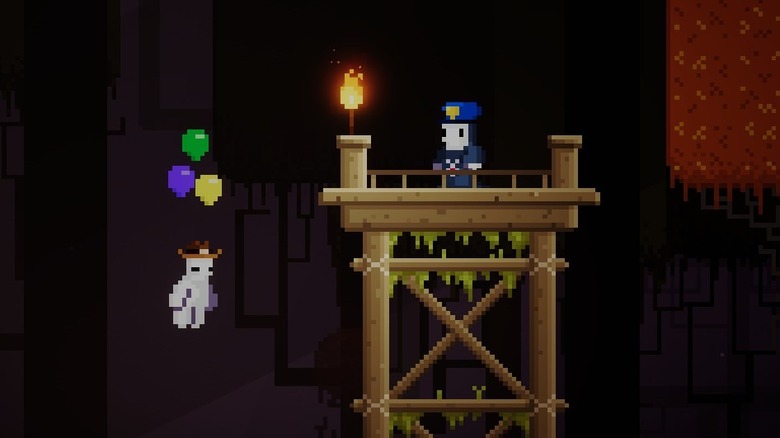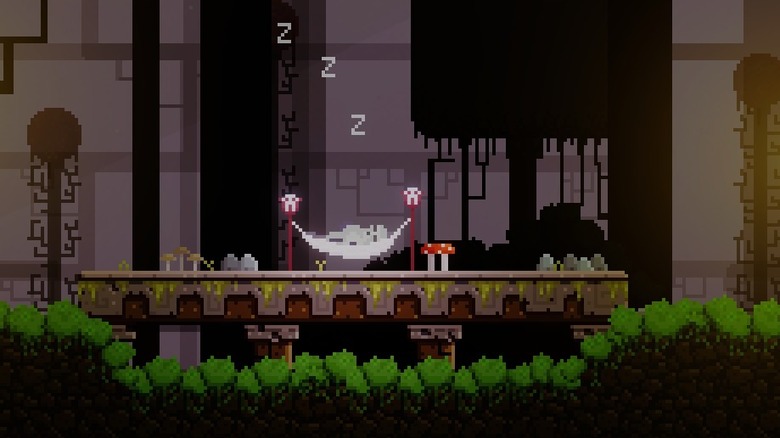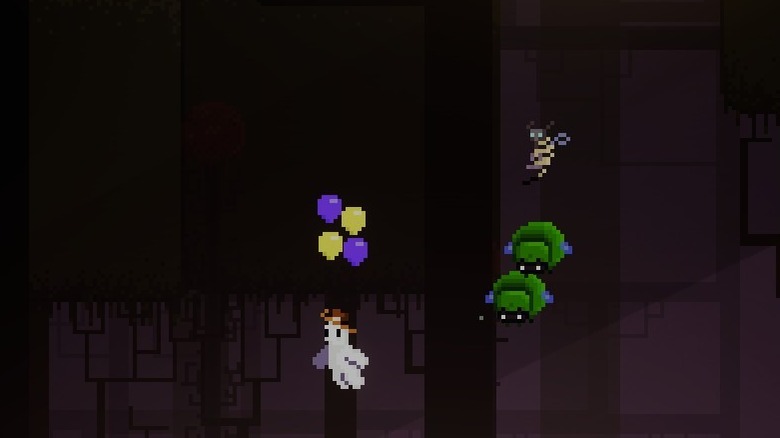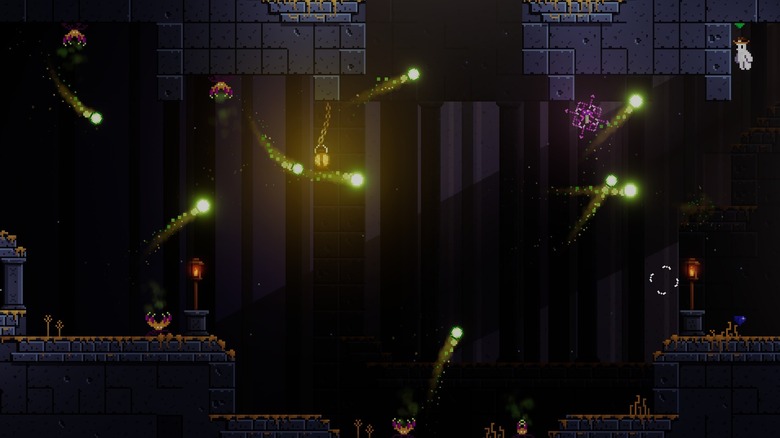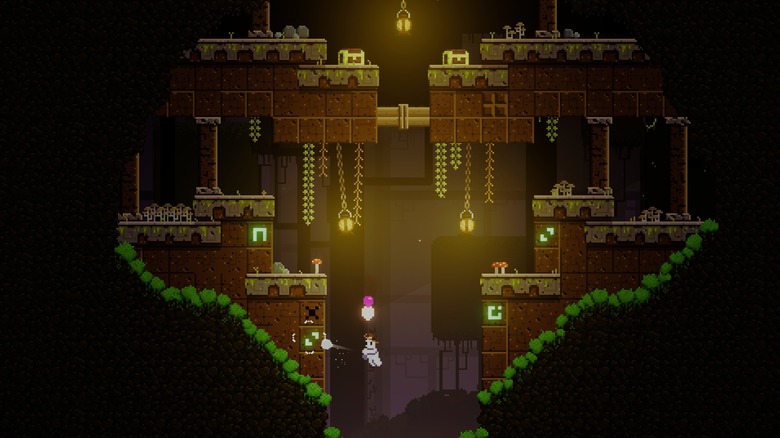Beyond The Long Night Review: A Classic Narrative With Lively Adventure
- Enchanting aesthetics
- Moderately intense shooting
- Delightful NPCs
- Simple twin-stick mechanics
- Permadeath gets tiresome
- Limited suite of upgrades
- Not much strategy opportunity
A PC review code was provided to SVG for this review. "Beyond the Long Night" is available now for PC on Steam and Itch.io.
Picture it: The stakes are high. The price to pay for a wrong move is your life. Bullets whiz past the last balloon holding you above a perilous, sure-death fall. You, a marshmallow with legs and a wide-brimmed hat, turn to fire your weapon at the angry bumblebee on steroids that's bracing to belch out a fireball directly at you. Thanks to a cursed gift imposed on you, your bullets go haywire, zinging past the insect come to send you to your maker. The winged beast, once so dainty and cute you'd think it was pollinating daisies just five minutes ago, bellows a sphere of embers from its fiery maw.
The last thing you see before the screen goes black is a glowing red circle colliding with the lone yellow balloon that was dutifully lifting you out of the dark subterranean prison.
This is "Beyond the Long Night," an indie twin-stick-shooter, action roguelike game published by Yogscast Games and developed by Noisy Head Games. In it, you are a determined explorer hellbent on escaping the labyrinthine kingdom beneath a mountain where you are trapped. These underground captives are cursed to live in a time loop, where a mysterious dark force runs rampant every night and other creatures are strangely opposed to your escape. Making it to the surface is your only hope.
A simple and nongroundbreaking narrative
The blueprint of "Beyond the Long Night" is a familiar one, in terms of roguelike games. Protagonist, who in this case is a sort of amorphous white monster/blob/Bubble Buddy, wants to escape the under for the other, the above — but is hindered by enemies and an opposing force that remains mysterious for the majority of the campaign. You don't learn much about the creatures in this game's underworld or why they're there, but the NPCs encountered in "Beyond the Long Night" are all endearing and quirky, with an impressive amount of humorous and thoughtfully-written dialogue for most characters.
It was the dialogue that polished up the game; the storyline itself, while craftily delivered and well-developed, isn't anything you haven't seen before. But again, "Beyond the Long Night" follows a beaten path in a very-well-done way. It's easy to enjoy grid-based movement games that include some sort of sweeping, crawling enemy force — think flooding, infection, any sort of slow-moving-but-unstoppable factor that blots out sections of your map or turns them into hazards — which is implemented by having the affected chambers inflict damage to the hero even when you're just passing through.
While there isn't anything to the game after the campaign is completed, its gameplay design offers quite a bit of replay value in that no two playthroughs will be the same — more on that shortly.
Strategy is an illusion in this type of game
If you are the type of player who likes complete autonomy over their abilities, boosts, power-ups, weaponry, and the like, "Beyond the Long Night" will push you far outside of your comfort zone. With each respawn, your inventory and power-up slate is wiped clean. The game's upgrades are granted at random, so there's no calculated application possible. Upgrades are also not optional — so if you uncover one that increases your rate of fire but sends bullets in helter-skelter curves, you just have to deal with it.
This, added on to the arbitrary procedural map generation and not knowing which NPCs or level-up rooms you'll encounter first (or ever), means that strategy in "Beyond the Long Night" stretches as far as bullet-flailing and a happenstance streak of good luck. You could wander through eight chambers of one map level before finding the next, or could make it through after just two or three. You could find the chamber with the NPC that sells upgrades — or you'll find the one with the murderous phoenix-parrot-thing that wants you dead. This can be gleefully frustrating; one run through the game could last half an hour because everything is going to plan, while the next sees you dead after just four minutes because the cards dealt left you sorely underprepared and overpowered.
One last note about upgrades: The new ones to discover run out pretty quickly. Almost every available upgrade and superpower can be discovered after about an hour into the game.
Progress is another fallacy
"Beyond the Long Night" is not immune to the Achilles' heels of roguelike games that spit players out into a procedurally-generated map. Permadeath — while varying in definition from era to era and game to game, is used here to define the lack of respawn opportunity in "Beyond the Long Night," where a death will spit you out at the very beginning — tends to taste increasingly bitter as your gameplay session goes on. Yogscast and Noisy Head, at least, justify the permadeath by explaining that the hero's underground world is stuck in a cursed time loop.
The painfully random nature of "the Long Night," with a complete dice-roll of early power-ups, no consistent abilities besides shooting to strategize with, and a luck-of-the-draw grid map for each rerun, can lead to a plummet in interest after maybe a half-dozen deaths, despite the initial intrigue in the randomized runs. When the second level or territory of the mountain you're ascending through is reached for the first time, a naive hope bubbles up that the entry to this level is a respawn point that'll save you the hassle of everything you just survived — but no. Entering the new sector, encountering new enemies and new challenges, often with plenty metaphorical still-bleeding wounds from the level prior, contained no such promise.
However, you've got to acknowledge this as the cough syrup, of sorts, of this game genre, not a flaw of "Beyond the Long Night." While some players prefer the sweet security of grueling for and finally achieving a checkpoint, there's no refusal to acknowledge the challenge and thrill posed here.
There could be more puzzle-based challenge, but it's still a fun play
With "Beyond the Long Night" being a twin-stick shooter, there's no surprise or complaint that the majority of the game is based on — duh — shooting. It's not quite a manic shooter, which hopefully reassures anyone who gets exhausted by endless tides of bullet spray. But offering occasional reprieve to the fray were tiny nuggets of puzzle-like strategy sparsely scattered throughout — a lot of rune matchmaking as pictured, along with some others. It's just enough to make the developers' intent to have some problem-solving flavor to the game evident, but not quite enough to meet the game's potential. There are also a lot of nooks and crevices that, in the beginning, can convince you that surely there is some secret chamber, Easter egg, or some kind of surprise lurking there — but these are either super hard to figure it out or these areas were included for a laugh on the devs' part.
All in all, "Beyond the Long Night" gets an 8 out of 10. Its moody, classically arcade-ish design, moderately intense shooting, quirky and likable NPCs, and distinctness in environment and enemies from level to level are great. The way your life count is indicated by how many balloons are helping you drift upward is an adorable touch, too. "Beyond the Long Night" doesn't have any weaknesses resulting from the game's development or execution — dungeon-crawling, grid-style roguelikes, as a whole, are an acquired taste. This one is remarkably well-done and definitely sets standards for the genre.

